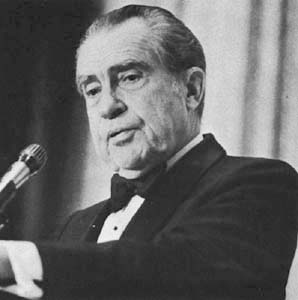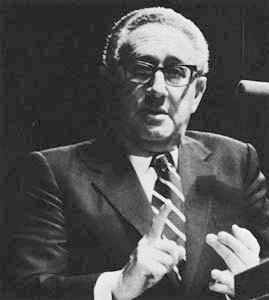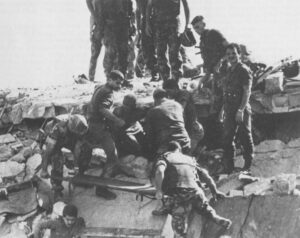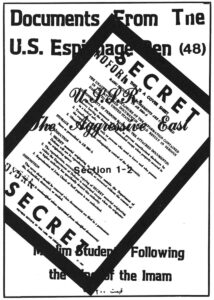Gregory J. Newell is the young man Ronald Reagan has put in charge of this administration’s policy on the United Nations. Newell, 35, as Assistant Secretary for International Organizations at the State Department, has decided the best way to implement Reagan’s policy of distrust of the UN is to oppose every budgetary proposal for the expenditure of new monies made by any UN organization. This is called Newell’s “budgetary policy” and not every one in the Foreign Service likes it.
One Foreign Service officer (FSO) posted in Geneva recently filed a cable through what is called the “dissent channel,” protesting that Newell’s rigid budgetary policy was often counter-productive. Thus, if a proposal was made to study the status of human rights in Soviet-occupied Afghanistan, the Geneva delegation would automatically have to oppose the measure even though the Reagan Administration would probably have liked to embarrass the Soviets with a critical UN report. The officer suggested that decisions on whether to vote for new expenditures ought to be left up to the U.S. delegation at each of the UN agencies.
Not a particularly momentous issue. But it was nevertheless one of the few dissent cables in recent years which received serious consideration in the Secretary of State’s seventh floor suite of offices in the State Department. Newell objected strenuously to the dissent cable. But Elliot Abrams, the Assistant Secretary for Humanitarian Affairs, favored the message. On two occasions, the matter was referred to the Under Secretary for Political Affairs at the time, Lawrence Eagleburger, and the Deputy Secretary, Kenneth Dam. A compromise was reached whereby Newell’s ironclad prohibitions on voting for any new budgetary items was upheld–with one exception. In the future, the Ambassador to the UN, Jeanne Kirkpatrick, will have the right to instruct a U.S. delegation to vote for a budgetary item.
This cable from our mission in Geneva was one of three formal dissents filed this year. Since the special channel was established in 1971, there have been 123 dissents. They have averaged about one a month. A record 28 were filed in 1977 under the Carter Administration, which everyone agrees created an atmosphere in which use of the channel was encouraged–or at least not stigmatized. Today, many officers flatly state they fear using the dissent channel. Only five such cables were filed last year under the Reagan Administration, and so far this year, there have only been three. All such dissent cables are classified, but after dozens of interviews conducted over the last six months, it is possible to describe more than a score of these unusual messages.
Policy Role
What role does the dissent channel play in the formation of policy? And is the decline in its use a signal that policy-makers are not receiving a properly varied range of analysis? “In my view,” writes Ambassador Alfred Atherton, Director General of the Foreign Service, in response to written questions, “it is possible that the decline in the use of the dissent channel you’ve cited represents the success of the system…rather than a deliberate effort to squelch differing views.”
Atherton argues that alternative views are expressed in other ways than cables. “Policy option papers by and large are prepared in Washington and many views are factored into both the documents themselves and the discussions that precede and follow the actual drafting. Viewing dissent channel cables as the sole measure of debate in the Department…represents a misunderstanding of the system.”
That policy option papers are by and large prepared in Washington may precisely be part of the problem. What the officers out in the field believe just is not very often a part of the policy debate in Washington. “When an officer gets busy,” says one veteran country desk officer, “these cables from the embassies just are not read. I do not read them…An action memo, however, which is written inside the Department and requires a policy-maker to check a yes or no box–that’s the kind of thing that makes a difference.”
Rarely is policy initiated or changed by the knowledgeable diplomat well-versed in a particular country’s political and cultural characteristics. In such a system, the dissent channel ought to, but doesn’t, provide a means for the expert in the field to change those politically motivated policies formulated in Washington which haven’t a chance of working given the realities on the ground. The dissent channel might have done much to constrain the more costly of our foreign policy adventures, particularly those motivated by crude domestic politicking. But 13 years after its establishment, the dissent channel is dying.

Initially, very few officers used the new channel, none in 1971 and only 4 in 1972. The first dissent cable was filed by Jack Perry, protesting the Christmas bombing of North Vietnam in 1972, on the eve of the Nixon-Brezhnev summit. Perry’s arguments, of course, had no impact on the Nixon-Kissinger Vietnam policy.

The first major test of the dissent channel as a means of not only venting views, but changing policy, came in Cyprus in 1974. In that year of the CIA-sponsored coup d’etat in Nicosia, Thomas Boyatt filed a dissent cable protesting Kissinger’s interventionist policy. Within days Boyatt was fired from his position as director of the Office of Cypriot Affairs. His dissent cable was not answered for five months, and even then, the response was merely an acknowledgment of receipt. (The system nevertheless took care of Boyatt; after Kissinger left the Department, he would make the ambassadorial grade.)
Mealy-Mouthed Response
In early 1975, Samuel R. Peale, the Deputy Chief of Mission in the United Arab Emirates, learned to his outrage that Washington had decided to renew formal diplomatic relations with Sudan, where only three years previously Ambassador Cleo Noel and his charge, George C. Moore, were assassinated. Peale, who had worked with Moore, quickly drafted a cable for regular channels and presented it to his ambassador, Michael Sterner, for his approval. Sterner, however, thought the message inappropriate for regular channels and suggested that Peale file it through the dissent channel. The cable was sent, but policy did not change, and Peale received what Sterner calls a “typically mealy-mouthed response.”
Other dissent cables filed over the years include:
a cable from the political counselor in our embassy in Cairo, Arthur L. Lowrie, an Arabist who wrote a provocative critique of the Camp David accords. One retired officer called it a “well-reasoned” cable which has stood up to events.
a report in the late 1970’s arguing that U.S. policy in the Persian Gulf was militarizing the region.
a cable from Panama suggesting that the danger to American travelers on the Pan American highway was so serious that warning signs ought to be posted. (The signs were posted.)
a warning from an officer in a consulate in Poland predicting that martial law was about to be imposed. (The cable never received an answer because shortly afterwards General Jaruzelski made his move. “What was the Department going to do,” says an officer familiar with the case, “pat the guy on the back and say, ‘You were right.’?”)
several cables from a political officer in the Bonn embassy criticizing Washington’s handling of German-U.S. relations.
a cable from an officer criticizing pending Congressional legislation designed to bar aid to an “unfriendly” developing country, probably Vietnam. The officer pointed out that the legislation would force the United States to renege on one of its formal treaty commitments.
another dissent channel cable from a U.S. Information Service officer stationed in Warsaw, critical of the Reagan Administration’s handling of economic sanctions against Poland.
With the exception of the Panama dissent, none of these dissent cables actually changed policy. One substantive dissent cable which came very close to reversing a policy decision occurred during the Carter Administration. A group of junior officers in the U.S. Mission to the United Nations drafted a dissent against the decision to vote for the seating of the Khmer Rouge UN delegation. Don McHenry, who would become our ambassador to the UN in the wake of Andrew Young’s resignation, says he disagreed with the dissent, but thought the drafters had a reasonable argument, one worthy of serious debate. He helped to re-draft the message, which impressed Secretary of State Cyrus Vance enough to change his mind. “It took some real arguing,” says one FSO, “to get the Secretary back on track. The honchos in the Bureau of Far Eastern Affairs really had to put on the pressure before Vance came back on board. I personally thought the Bureau was right. To unseat the Khmer Rouge, as awful as they are, would alienate our ASEAN (Association of Southeast Asian Nations) friends and reward Vietnamese aggression.”

Another FSO, working at the time as an aide to Assistant Secretary for the Far East Richard Holbrooke, says he supported the dissent. “I thought that in the long term we would be better off distancing ourselves from the Khmer Rouge. Holbrooke saw it differently.”
Precisely because few dissent cables have ever changed policy, use of the dissent channel is considered a desperate last resort. Most officers want to be known as team players and believe their careers will suffer if they become stigmatized as a “dissenter.” Arthur W. Purcell is a case in point. In 1977 Purcell filed as many as a dozen dissent cables from his position as a Labor officer in Melbourne, Australia. Purcell eventually filed a formal protest before the Foreign Service Grievance Board and their report, dated November 13, 1978, demonstrates just how vulnerable the lone dissenter can be in the Foreign Service.
In July, 1976, Purcell was invited by our Ambassador in Australia, James W. Hargrove, a political appointee, to give an oral presentation on the labor situation in Australia. Eight months previously, the Australian Labor Party had been unseated by the Governor-General in a highly controversial move that has ever since elicited suggestions of external intervention. U.S. strategic interests in Australia were seen threatened by the Labor Party’s hints that they might throw the U.S. out of its Pine Gap listening post in northern Australia. Purcell told Ambassador Hargrove’s “country team” that day that it was his conclusion that since the Liberal Party had taken power “industrial relations performance of the government had been quite poor,” and he thought “the Communist tail was not wagging the trade union dog in Australia.” Purcell says his presentation was “frostily” received because his colleagues disputed his assessment, particularly on the issue of Communist influence in the trade union movement.
Tendentious Report
Then, in January, 1977 Purcell submitted his annual labor report for transmittal to Washington. More than a month later, Ambassador Hargrove finally forwarded Purcell’s report to Washington. But he had attached a cover note disavowing the analysis, calling it “tendentious and, in some instances, factually erroneous.” To make matters worse, the embassy had taken the unheard of action of preparing its own annual labor report.
It was at this point that Purcell, discovering that the embassy refused to forward his reporting, began filing his cables on the labor situation through the dissent channel. In response, the Ambassador informed the State Department that Purcell had “expressed a reluctance to pursue the political objectives of the Mission…(and) he certainly does not represent the Mission views of what is happening on the labor scene in Australia.” Ambassador Hargrove also tried to argue with State that Purcell’s use of the dissent channel was improper.
In the spring of 1977 Purcell received his first efficiency rating for his 14 months service in Australia. Not surprisingly, the rating was the lowest he had ever received. Purcell filed another dissent cable, protesting that he was being penalized for his original use of the channel for transmittal of his labor reports. (In September, 1977 he sent three reports on “Industrial Unrest in Australia” to the Canberra embassy for transmittal to Washington. When the embassy failed even to acknowledge the reports, let alone forward them to the State Department, Purcell sent them through the dissent channel. He used the dissent channel once again in November to transmit a report on a Victoria power strike.)
In the meantime, another political appointee, Philip H. Alston, Jr., replaced Hargrove as ambassador. After one meeting with Purcell, Alston cabled the Director General of the Foreign Service and requested Purcell’s transfer. Alston cabled the Director General, “I would hope, that on reflection Mr. Purcell might forego insistence on exhausting his rights under established procedures.” And according to Purcell, the new ambassador told him, “I don’t think you have much chance of winning if you are fighting an ambassador and a DCM (Deputy Chief of Mission).”
Purcell by this time had decided to take early retirement and left the service at the end of 1977. But he continued to pursue his case before the Grievance Board. In late 1978 the Board released its findings: the Board faulted Purcell for his “somewhat ‘angular’ personality” and said, “His qualities of independence and uncompromising integrity have been described by some supervisors as admirable and positive traits, but they have also been seen as demonstrating willful stubbornness and self-righteousness that have constituted an impediment to effective performance.”
But aside from this comment, the Board upheld Purcell on all counts. It found “the grievant’s use of the Dissent Channel entirely appropriate under the circumstances.” It also concluded that Purcell had been “penalized for using the Dissent Channel.” The Board ruled that the poor efficiency ratings given Purcell be expunged from his file, concluding that, “The three examples given by the rating officer of the grievant’s faulty judgment were considered by expert witness Harris to be examples of his correct judgment and to reflect the rating officer’s lack of understanding of the labor situation being described.” Finally, the Board deplored Ambassador Alston’s attempts to prevent Purcell from pursuing his grievance. Purcel had asked that formal letters of “reprimand” be placed in the files of the Canberra officers who had violated dissent channel regulations. On this point only, the Grievance Board balked, saying, “Neither Ambassador is a career officer and neither has a performance folder in which to insert a letter of reprimand.”
Fear of Retribution
Purcell’s is not an isolated affair. There is the case of H. Allen “Tex” Harris, an FSO assigned to report on human rights in Argentina in 1977. Harris’ reporting so antagonized his ambassador, a political appointee named Raul Castro, that he eventually had to use the dissent channel. Like Purcell, Harris received extremely poor efficiency ratings and hasn’t been promoted since his Argentine tour. (But he was honored this year with the William R. Rivkin Award, given by the American Foreign Service Association in recognition of his “bureaucratic courage to stand up for what was right…”) The Grievance Board in 1979-80 handled at least two other cases involving interference with use of the dissent channel.
None of this, of course, has encouraged officers to use the dissent channel. “I don’t know if the decline in use (of the dissent channel) is a reflection of orthodoxy,” says Undersecretary for Political Affairs Michael Armacost, “or fear of the consequences.”
John Reinertson strongly believes that fear of retribution is a major cause for the decline in use of the dissent channel. Reinertson was until recently the elected chairman of the State Department’s “Open Forum,” which among other things, is supposed to monitor the dissent channel. Open Forum was established back in 1967 as a voluntary member organization dedicated to encouraging in-house debate on foreign policy. It hosts a well-attended speaker’s program and publishes a classified quarterly Open Forum Journal, where alternative policy ideas are given a hearing.
Reinertson’s one year term as Chairman of Open Forum, which ended last summer, was marked by an unprecedented bureaucratic turf fight. In a recent editorial of the Open Forum Journal Reinertson says that the dissent channel is “one important index of individual political integrity” within the Foreign Service. “By that index,” writes Reinertson, “we are failing badly.” In an interview, he said that under the Reagan Administration “alternative ideas are less welcome,” and “fear is fairly pervasive.”
Such outspoken views have not endeared him to high ranking officers in the State Department. When a dissent cable arrived from Poland last year on the subject of economic sanctions, Reinertson thought the response, drafted under the supervision of Stephen Bosworth, the Chairman of the Policy Planning Council, was inadequate. Open Forum operates out of the Policy Planning Council, which is charged with drafting the formal response to all dissent channel messages within 30 days.
Harry Jones, Bosworth’s special assistant at the time, explains: “Reinertson came in telling people his job was adversarial, that he was supposed to keep tabs on what we were doing…He then started commenting on substantive policy matters in memos directly to the Secretary. The subject was the dissent cable from Poland. He had a different view of the matter and apparently did not think our reply was responsive enough. We didn’t even find out about the memo he wrote to the Secretary until it had already gone out…He had sent it directly to the Secretary without showing it to Ambassador Bosworth, let alone clearing it with him.”
Reinertson says the regulations governing his duties as Open Forum Chairman give him every right to ensure that dissent cables receive adequate replies. And that means direct access to the Secretary.
Jones chalks up the dispute to “a personality clash” between Reinertson and Bosworth. But while Bosworth has moved on to become ambassador to the Philippines, and Reinertson’s term as Open Forum Chairman has lapsed, the issue has not faded. An informal working group set up within Open Forum, calling itself the Sages’ Group, has drafted a set of 17 very specific proposals designed to increase the autonomy and power of the Open Forum Chairman. The Sages want Open Forum taken out from under control of Policy Planning and placed directly in the Secretary’s office. They want a separate budget and both full-time chairman and vice chairman, with their own support staff. They believe the Open Forum Chairman should have the right to sit in on the Secretary’s staff meetings and any other meetings throughout the Department.
Regarding the dissent channel, they have only harsh words for how it presently operates: “One can sense a serious problem–a cynical, some would say ‘realistic,’ attitude that perceives the Dissent Channel as merely a management tool for letting the system vent bottled-up pressures…without affording these dissenting voices a real impact on policy.” The Sages charge that neither the Secretary nor the Undersecretary presently ever see dissent messages; they want promises that these two highest officials will personally read and personally direct the replies to the messages. Finally, they want the dissent messages themselves to receive wider distribution, including publication in the Open Forum Journal.
When the Sages’ preliminary proposals were brought before a general meeting of the Open Forum membership on June 26th, Reinertson gave a speech criticizing the present system of handling dissent messages, only to be followed by the new Chairman of Policy Planning, Peter Rodman, who talked of how splendidly the dissent channel was working. Significantly, Secretary George Schulz, arriving late, gave a short speech echoing Kissinger’s 1973 concern that dissents must not be leaked to the press.
Obviously, however low morale falls within the Service on this issue, the men on the receiving end of the dissent messages will be very reluctant to accept “reforms” which empower the Chairman of Open Forum, an elected position, with significant influence over the policy-making process. Nor, of course, is the Secretary institutionally inclined to encourage the filing of more numerous dissent messages. Many officers, in fact, will argue that the Sages’ efforts are misplaced.
“The dissent channel is a crock,” says one FSO working in the Far East Bureau. “If you feel strongly enough about an issue, you go to your Ambassador and you do what you must to get things changed. That may mean telling him that you know his wife will be very unhappy if she learns about the attentions he has given a certain young secretary…I have known officers who have gone to such lengths.”
Yet another officer insists, “if my ambassador and his political counselor could not convince me that a cable I had drafted was off base, then it would go out. There’s always a way to get your views back to Washington short of the dissent channel. Once I had a damn good cable which the political counselor decided shouldn’t go out. I told him, OK, let’s just send it to the ambassador as a memo for his information. I knew the ambassador would take one look at it and instruct that it be sent as a cable with his name on it. That’s what happened.”
Ambassador Boyatt, whose dissent cable on Cyprus in 1974 is well known, nevertheless observes, “People know they’ll have their inning sooner or later.” Boyatt is one of the few ambassadors who routinely cleared cables containing views with which he did not necessarily agree. “More than one cable,” says Boyatt, “went out saying ‘Our counsels are divided.’ That’s how I ran my embassy…if I didn’t like a cable, I would merely add an ambassador’s paragraph spelling out my differences.”
Phil Kaplan, a ranking officer in Policy Planning, disagrees with this approach. “The ambassador’s name goes on any assessment, so there can only be one view. It’s not like a bunch of newspaper reporters; there are consequences to our reporting where there are none for a reporter…A good officer can iron out a position with his superiors in a way that his views do get reported. But ultimately, there can be only one assessment and I wouldn’t have it any other way.”
Director General Atherton maintains that the system is working, that “The Department as an institution encourages an atmosphere of debate, but if some few resist it, it is hard to imagine that an institutional fix can remedy the situation.”
In the deepest sense, Atherton is probably right; there may be no easy institutional fix. But there are some obvious reforms which could help to engender an atmosphere of vigorous debate. It might, for instance, make an enormous difference if the Department had publicly reprimanded the ambassadors who penalized Arthur Purcell, “Tex” Harris and others for using the dissent channel. It would also make a difference if the officers serving in the field had greater influence over the policy-making process. Our diplomats abroad, after all, are closest to the facts. But except in the case of a crisis, when events are moving too quickly for Washington to know anything, the embassies rarely take the initiative in setting down a policy line. And why maintain the pretense that everything reported from the field has the ambassador’s imprimatur on it? Why shouldn’t the ambassador take the credit (and the blame) for only those cables which he or she actually authored? In the cast of routine reporting, why shouldn’t the ambassador be required to let “a hundred flowers bloom?”
The Sage Group’s proposals represent an attempt to introduce a greater degree of accountability into the process. Those officers, such as John Reinertson and Tom Boyatt, who are alarmed by the decline in the use of the dissent channel, know that for every policy adopted regarding the Middle East, Central America, or the Soviet Union, there is an alternative, but equally coherent, view that could be expressed, but isn’t. Instead, we have an atmosphere which rewards conformity and discourages all but the most aggressive officers from thinking they can influence policy with their reporting. If we are to have a professional foreign service, then we deserve better.
©1985 Kai Bird
Kai Bird, foreign affairs columnist on leave from The Nation, is investigating the U.S. Foreign Service.




